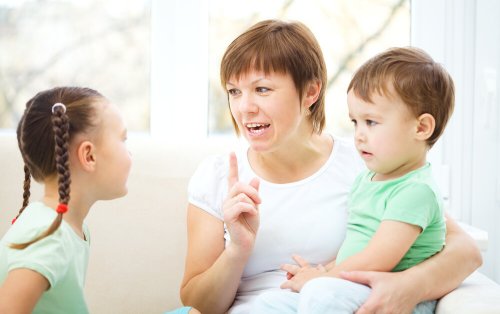Magic Words: Please, Thank You, Sorry

The use of magic words with your children at home can reduce tension and help raise helpful and grateful adults.
Teach your children about good manners from an early age. If you do, they’ll always be respectful.
Magic words are part of what is known as good manners. Teaching your child to use these words will surely help them grow up to be respectful adults.
However, this is no easy task. It requires a lot of dedication. Learn how to incorporate “thank you”, “please”, “excuse me” and “sorry” into your vocabulary at home.
The importance of magic words
You’ve surely noticed how hearing someone say “good morning”, “thank you”, “excuse me”, and “please” completely changes the perception you have of them.
This is even more important when it comes to children. It can help them increase their level of socialization which will in turn help them adapt to their environment and surroundings.
These words allow them to interact with their peers effectively. They also stimulate positive reactions and social inclusion.
Ways to teach children the magic words
The best way to teach your children these magic words is by example. You should include them in your daily conversations with family, friends, neighbors and of course, with your children.
There are also other techniques that can encourage their use of these words. Here are a few examples:
Teach your children the meaning of these magic words
When your children reach a certain age, you can explain to them why manners are important.
Here are the meanings of these great words.
- Thank you. It shows gratitude towards generosity. Teaching them to say this simple word will help make them grateful children capable of valuing the efforts of others.
- Please. This word teaches children that things aren’t obtained if they ask for them disrespectfully. Help them recognize that others have the right to share or not.
- Sorry. Saying sorry sincerely helps the child recognize their mistakes and strive to correct their actions.
- Good morning. This is a greeting that indicates that everyone deserves fair and kind treatment.

Make it fun
Teaching a child to use these magic words doesn’t have to be boring.
Try using songs, games or stories that show the relationship between good manners and positive consequences.
Some examples of stories that can be used to encourage politeness are: The magic tree and The nails and love.
Stimulate good manners with their friends
The first contact children have with their mates is in kindergarten. That’s where they’ll learn to interact with classmates and teachers.
Teach them to say hello when they arrive, to ask for toys with the magic word “please” and to say sorry when they’re wrong.
Be patient
Incorporating these words requires effort, patience, perseverance and a lot of dedication. That means you’ll have to remind them frequently before it becomes a habit.
A good alternative is to ask them: “What about the magic words?” This will help them remember them.
Hearing someone say “good morning”, “thank you”, “excuse me”, and “please” completely changes the perception you have of them.
Do some hands-on sessions and set realistic goals
Teach your little one that when they use the magic words they make others feel good.
Practice how to greet your neighbors, when to say thank you and when to say excuse me or sorry. This will prepare them for the challenge.
Don’t force learning
During this process, there are certain things you should never do, such as:
- Don’t humiliate the child or force them to say hello if they feel embarrassed. The process of using magic words can be a bit slower in children who are shy.
- Don’t negotiate with the child. They must learn to be polite without expecting anything in return.
- Don’t tell others about the process your child is undertaking.
Explain the positive results of being polite
Teach them to understand the relationship between their actions and the consequences they generate.
For example, an excellent example is to say: “your grandmother was so happy that you said thank you.”
Letting them know they’re doing well will encourage them to continue to put what you teach them into practice.
In conclusion, having well-mannered children requires a lot of dedication and continuous effort from parents.
You should praise them when they do well, watch out for bad influences and reinforce positive learning.
These magic words will eventually transform into many great opportunities for them in life.
The use of magic words with your children at home can reduce tension and help raise helpful and grateful adults.
Teach your children about good manners from an early age. If you do, they’ll always be respectful.
Magic words are part of what is known as good manners. Teaching your child to use these words will surely help them grow up to be respectful adults.
However, this is no easy task. It requires a lot of dedication. Learn how to incorporate “thank you”, “please”, “excuse me” and “sorry” into your vocabulary at home.
The importance of magic words
You’ve surely noticed how hearing someone say “good morning”, “thank you”, “excuse me”, and “please” completely changes the perception you have of them.
This is even more important when it comes to children. It can help them increase their level of socialization which will in turn help them adapt to their environment and surroundings.
These words allow them to interact with their peers effectively. They also stimulate positive reactions and social inclusion.
Ways to teach children the magic words
The best way to teach your children these magic words is by example. You should include them in your daily conversations with family, friends, neighbors and of course, with your children.
There are also other techniques that can encourage their use of these words. Here are a few examples:
Teach your children the meaning of these magic words
When your children reach a certain age, you can explain to them why manners are important.
Here are the meanings of these great words.
- Thank you. It shows gratitude towards generosity. Teaching them to say this simple word will help make them grateful children capable of valuing the efforts of others.
- Please. This word teaches children that things aren’t obtained if they ask for them disrespectfully. Help them recognize that others have the right to share or not.
- Sorry. Saying sorry sincerely helps the child recognize their mistakes and strive to correct their actions.
- Good morning. This is a greeting that indicates that everyone deserves fair and kind treatment.

Make it fun
Teaching a child to use these magic words doesn’t have to be boring.
Try using songs, games or stories that show the relationship between good manners and positive consequences.
Some examples of stories that can be used to encourage politeness are: The magic tree and The nails and love.
Stimulate good manners with their friends
The first contact children have with their mates is in kindergarten. That’s where they’ll learn to interact with classmates and teachers.
Teach them to say hello when they arrive, to ask for toys with the magic word “please” and to say sorry when they’re wrong.
Be patient
Incorporating these words requires effort, patience, perseverance and a lot of dedication. That means you’ll have to remind them frequently before it becomes a habit.
A good alternative is to ask them: “What about the magic words?” This will help them remember them.
Hearing someone say “good morning”, “thank you”, “excuse me”, and “please” completely changes the perception you have of them.
Do some hands-on sessions and set realistic goals
Teach your little one that when they use the magic words they make others feel good.
Practice how to greet your neighbors, when to say thank you and when to say excuse me or sorry. This will prepare them for the challenge.
Don’t force learning
During this process, there are certain things you should never do, such as:
- Don’t humiliate the child or force them to say hello if they feel embarrassed. The process of using magic words can be a bit slower in children who are shy.
- Don’t negotiate with the child. They must learn to be polite without expecting anything in return.
- Don’t tell others about the process your child is undertaking.
Explain the positive results of being polite
Teach them to understand the relationship between their actions and the consequences they generate.
For example, an excellent example is to say: “your grandmother was so happy that you said thank you.”
Letting them know they’re doing well will encourage them to continue to put what you teach them into practice.
In conclusion, having well-mannered children requires a lot of dedication and continuous effort from parents.
You should praise them when they do well, watch out for bad influences and reinforce positive learning.
These magic words will eventually transform into many great opportunities for them in life.
All cited sources were thoroughly reviewed by our team to ensure their quality, reliability, currency, and validity. The bibliography of this article was considered reliable and of academic or scientific accuracy.
- Bowlby, J. (1986). Vínculos afectivos: formación, desarrollo y pérdida. Madrid: Morata.
- Bowlby, J. (1995). Teoría del apego. Lebovici, Weil-HalpernF.
- Garrido-Rojas, L. (2006). Apego, emoción y regulación emocional. Implicaciones para la salud. Revista latinoamericana de psicología, 38(3), 493-507. https://www.redalyc.org/pdf/805/80538304.pdf
- Jacob, S. R. (2004). Prosocialidad y autoestima. [Tesis de grado, Facultad de Ciencias de la Educación, Universidad FASTA]. Repositorio Institucional. http://redi.ufasta.edu.ar:8082/jspui/handle/123456789/1401
- Marrone, M., Diamond, N., Juri, L., & Bleichmar, H. (2001). La teoría del apego: un enfoque actual. Madrid: Psimática.
- Medina Moreno, B., Patiño Ramírez, Y. A., Pérez Castellanos, J. K., Piedrahita Fonseca, L. Y., & Ruiz Parra, M. A. (2015). El cuento como estrategia pedagógica para fortalecer los comportamientos prosociales en los niños y niñas del nivel preescolar. [Tesis, Universidad Pedagógica de Bucaramanga]. Repositorio Institucional. https://repository.unab.edu.co/handle/20.500.12749/901
-
Méndez, P. L., Serna, J. H. G., Gallego, P. P., Rendón, L. B., & Botero, C. A. (2015). GUIA práctica sobre Pautas de Crianza y Relaciones Familiares. Ediciones de la Gobernación de Risaralda.
- Moneta, M. (2003). El Apego. Aspectos clínicos y psicobiológicos de la díada madre-hijo. Santiago: Cuatro Vientos.
- Pérez, V. M. O. (2007). La buena educación: Reflexiones y propuestas de psicopedagogía humanista. Anthropos Editorial.
- Valencia, L. I. (2012). El contexto familiar: un factor determinante en el desarrollo social de los niños y las niñas. Poiésis, (23). https://revistas.ucatolicaluisamigo.edu.co/index.php/poiesis/article/view/332
This text is provided for informational purposes only and does not replace consultation with a professional. If in doubt, consult your specialist.








